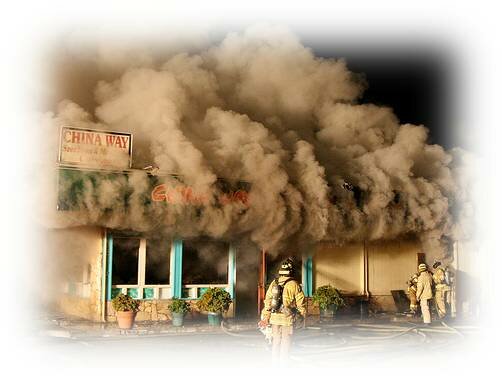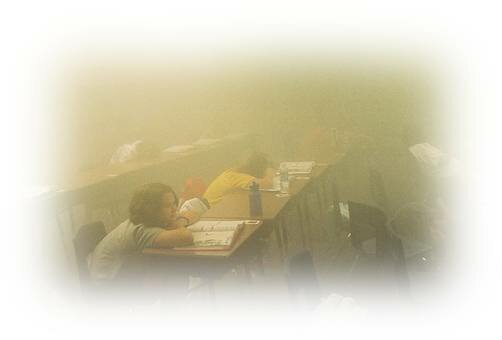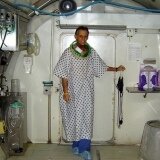Carbon Monoxide Poisoning
And Hyperbaric Oxygen Therapy

Carbon Monoxide Poisoning is a leading cause of death by poisoning in the United States. 7, 8 Among causes of Carbon Monoxide Poisoning are automobile exhaust (accidental or purposeful), faulty heaters, and building fires.
Many factors affect the carbon monoxide poisoning symptoms and the outcome of treatment.
Most significant factors are: the inhaled CO concentration, duration of exposure, rate and depth of breathing, heart rate, co-morbid illnesses and most importantly, the time between discovery of the patient after exposure and arrival at a Hyperbaric Chamber.

Photo courtesy of "smokeshowing"
The following information is re-produced by permission of UHMS
121.
©2008 Undersea and Hyperbaric Medical Society, Inc. The book can be purchased at
UHMS web site.
Carbon Monoxide Poisoning
Stephen R. Thom, M.D., Ph.D., FACEP and
Lindell K. Weaver, M.D., FACP, FCCP, FCCM
The injuries caused by carbon monoxide (CO) traditionally have been viewed as due to a hypoxic stress mediated by an elevated carboxyhemoglobin (COHb) level. The two organ systems most susceptible to injury from CO are the cardiovascular and central nervous systems. Human and animal data indicate that major cardiac injury is due primarily to CO-induced hypoxic stress.
However, the COHb level does not correlate well with the development of neurological injuries. Recent investigations have established that systemic oxidative stress can arise from exposure to CO and that perivascular and neuronal injuries arise by mechanisms other than hypoxia. Neuropathology seems to be due to a complex cascade of biochemical events involving several pathophysiologic processes.
Administration of supplemental oxygen is the cornerstone of treatment of CO poisoning. Oxygen inhalation will hasten disassociation of CO from hemoglobin dissociation to occur at a rate greater than that achievable by breathing pure oxygen at sea-level pressure.
Additionally, HBO2, but not ambient pressure oxygen treatment, has several actions which have been demonstrated in animal models to be beneficial in ameliorating pathophysiologic events associated with central nervous system (CNS) injuries mediated by CO.
These include an improvement in mitochondrial oxidative processes, inhibition of lipid peroxidation, and impairment of leukocyte adhesion to injured microvasculature. Animals poisoned with CO and treated with HBO2 have been found to have more rapid improvement in cardiovascular status, lower mortality, and lower incidence of neurological sequelae.
Since 1960, the clinical use of HBO2 for CO poisoning has occurred with increasing frequency. Over 2,500 CO-intoxicated patients were treated in North American hyperbaric chambers in 1992. However, this is only a small fraction of those poisoned with CO. Extrapolation of data from a 1994 survey across three western states projected that over 4,000 CO-poisoned patients are evaluated in emergency departments annually in the United States.
In reported series, clinical recovery among patients treated with HBO2 appears to be improved beyond that expected with ambient pressure supplemental oxygen therapy. This has been observed both in terms of mortality and neurologic morbidity.
This research found that the optimal benefit from HBO2 occurs in those treated with the delay after exposure and that repeat treatments may yield a better outcome than just a single treatment in selected patients.121

Photo courtesy of Kyle Kesselring
Further Reading...
-
-
-
- Hyperbaric Oxygen Treatment : The Last Frontier. Philip B James MB ChB, PhD, DIH, FFOM
- Treatment of Diabetic Ulcer Wounds By Hyperbaric Oxygenation. Review Of Scientific Trials Concerning Diabetic Foot Ulcers
- Retinopathy of prematurity may be prevented by the intermittent use of higher dosages of oxygen.
- Hyperbaric Oxygen Treatment (HBOT): oxygen transport to ischemic / hypoxic tissues is explained in this article by analyzing the physics and physiology of oxygen.
- Why Hyperbaric Oxygen Therapy is the most natural way of letting the body to heal itself...
- Aerobic Cellular Respiration Overview...
- TRCS - Transportable Recompression Chamber System For Emergency Evacuation And Treatment.
- Acute Brain and Cardio-Respiratory Dysfunction After Blast/Blunt Injuries: The Life-Preserving Effects of Hyperbaric Oxygenation...
- Diseases of the Respiratory System.
- Oxygen Toxicity Overview
- Characteristics for Autism Spectrum Disorders and diagnostic criteria.
- Near Drowning Overview.
- HBOT: historical perspective and physical basis...
- Hypoxia is sometimes dangerous, life-threatening state for our cells and tissues. Learn about hypoxia symptoms, causes and types...
- SPECT - Single Photon Emission Computed Tomography Emission Computed Tomography, a type of nuclear imaging showing how blood flows to tissues of organs.
- Air Embolism, the definitive treatment of which remains Hyperbaric Oxygen Therapy (HBOT).
- Carbon Monoxide Poisoning, recovery among patients treated with Hyperbaric Oxygen appears to be improved beyond that expected with ambient pressure supplemental oxygen therapy...
- Cyanide poisoning in combination with carbon monoxide poisoning frequently occur simultaneously in victims of fires, smoke inhalation, military operations and industrial accidents.
- For Gas Gangrene (Clostridial Myonecrosis) and Clostridial Myositis or spreading clostridial cellulitis with systemic toxicity the preferred treatment is a combination of Hyperbaric Oxygen Therapy (HBOT), Surgery, and Antibiotics.
- Crush injury is directly associated with trauma while skeletal muscle compartment syndromes arise from ischemia, venous outflow obstruction, exertion, external compression as well as trauma.
- Hyperbaric Oxygen Treatment Center At Elisha & Rambam Hospitals
- With Compartment Syndrome, Hyperbaric Oxygen Therapy (HBOT) when used as an adjunct to a surgery and antibiotics shows promise as a way to decrease complications and morbidity.
- Decompression Sickness - definition, symptoms and treatment of choice...
- Non healing wounds like diabetic foot ulcers can benefit from HBOT.
- Exceptional Blood Loss Anemia and Hyperbaric Oxygen Therapy (HBOT) as adjunctive therapy to win the time for survaval...
- Subdural empyema and other intracranial or cerebral abscesses are usually caused by anaerobic bacteria (bacteria that function optimally in low oxygen concentrations)...
- Necrotizing wound infection may result from either a single strain or a mixed population of bacteria, typically occurring after trauma, surgery, and/or around foreign bodies...
- Refractory osteomyelitis is a chronic osteomyelitis which often does not responded to the treatment administrated. HBOT directly kills or inhibits the growth of infection also augmenting the efficacy of bacterial killing by antibiotics.
- Tissue necrosis, bone necrosis and other radiation injuries as a delayed complications of radiation exposure...
- Skin graft survive when oxygen and nutrients diffuse into them from the underlying wound bed...
- Thermal Burns: HBOT when used as an adjunct in a comprehensive program of burn care, can significantly improve morbidity and mortality, reduce length of hospital stay, and lessen the need for surgery.
- The appearance of early symptoms of autism is a reason to have a child evaluated by a professional specializing in Autism Spectrum Disorders. See the autism symptoms checklist...
- Several autism types have been defined along the autism spectrum, differing in the severity of the symptoms and total disability and in the combinations of autistic impairments with other disabilities.
- Autism And Vaccinations: Clear Answers & Smart Advice About Your Babys Shots
- Portable Hyperbaric Chambers and HBOT should become an important player in humanitarian efforts in support of casualties sustained by individuals from natural disasters, battlefields and terrorist acts...
- Portable Hyperbaric Chambers SOS Hyperlite
- In spite of a number of existing Autism treatments, there are no miracle autism cures. For many realistic parents striving to help their autistic kids to feel less frustrated, communicate, perform and feel better, one of the crucial questions is what is the correct course of the autism treatment?















